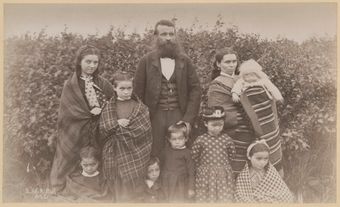Indigenous Peoples are the first people to live in what is now Canada. There are three main groups of Indigenous Peoples in Canada. They are First Nations, Métis and Inuit. There is a lot of diversity in these groups. They have their own cultures, languages and experiences.
(This article is a plain-language summary of Indigenous peoples in Canada. If you are interested in reading about this topic in more depth, please see our full-length entry, Indigenous Peoples in Canada.)

First Nations
First Nations is a term for Indigenous Peoples who are not Métis or Inuit. They are the original inhabitants of what is now Canada. There 634 First Nations in Canada who speak more than 50 languages. “First Nations” is only a general term. First Nations people are likely to identify with specific nations, or communities in those nations. Most First Nations live in the land south of the Arctic. Some live in cities and towns, but many live in communities called reserves. In 2016, the First Nations population was 977,230.
Métis
Métis have mixed European and Indigenous ancestry. Métis live in the Prairie provinces and Ontario. But they also live in other parts of Canada. Métis means different things to different people and groups. The term is used to describe communities of mixed ancestry. It also refers to a specific community, the Métis Nation. The Métis Nation grew in Western Canada around the Red River Colony in the 1800s. The most-spoken Métis language is called Michif. It is a mixture of Cree, Saulteaux (Ojibwa) and French. In 2016, the Métis population was 587,545.
Inuit
Inuit mainly live in the northern regions of Canada. The word for one member of this group is “Inuk”. Their homeland is known as Inuit Nunangat. This is the land, water and ice in the Arctic region. There are eight main Inuit ethnic groups. Inuktitut, the Inuit language, has five main dialects in Canada. In 2016, the Inuit population was 65,025.
History
For thousands of years, Indigenous peoples lived in complex societies. They all had political systems. They all had economies. They all had religions. They all had art. And, they all had science. They were, however, very different from each other. For example, First Nations in British Columbia are different from First Nations in Ontario. They also might be similar in some ways. Even inside these groups there are differences among bands.
Indigenous peoples were changed forever after Europeans arrived. This is called colonization. Colonization changed Indigenous ways of life. Many restrictions and limits were put on Indigenous peoples. This was to make them more like Europeans and erase their culture. This is called assimilation. Colonization and assimilation still affect Indigenous peoples today. They have harmed their health, their lands and their well-being.
One of these laws was the Indian Act. It still exists today. It is the law the government uses to manage Indigenous affairs. (See Indian Act (Plain-Language Summary).) Canada’s highest law, the Constitution, also is meant to protect Indigenous peoples. Many Indigenous nations signed treaties with the British government. These are with Canada today. They are agreements for the use of Indigenous lands for payments or other benefits. Treaties are the legal and moral base of alliances with Indigenous peoples and Canada. (See Treaties with Indigenous Peoples in Canada (Plain-Language Summary).)

 Share on Facebook
Share on Facebook Share on X
Share on X Share by Email
Share by Email Share on Google Classroom
Share on Google Classroom








